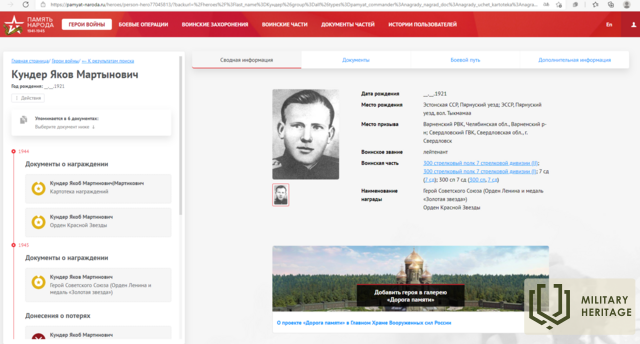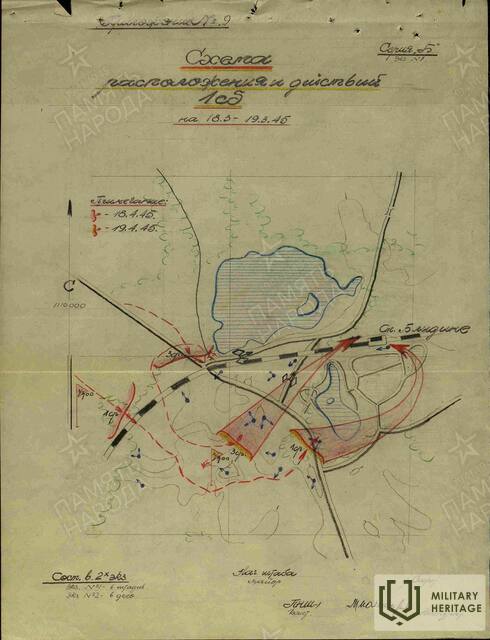The feat of Hero of the Soviet Union - Lieutenant Jakob Kunder of the 8th Estonian Corps
The heroic actions of fallen officer Jakob Kunder of the 8th Estonian Rifle Corps of the Red Army ensured the successful assault of the battalion, but he himself was killed, and a monument has been dedicated to Jakob Kunder at the site of his fall and a monument has been erected at the Tuškis Brothers Cemetery.
“Certificate of award of Hero of the Soviet Union to Lieutenant Jakob Kunder:
On March 17, 1945, the 1st Company received an order from the battalion commander to seize the “Barracks” and the Blīdene station. On the night of March 18, Comrade Kunders broke into the “Barracks” with a platoon, which the enemy had turned into a fortified place, transforming the windows of the buildings into embrasures. With skillful leadership, Comrade Kunders captured the “Barracks”, thus occupying part of the enemy’s fortifications. Remaining in the “Barracks” under temporary defense, Comrade Kunders used the fortified support point built by the enemy.
On the morning of March 18, 1945, the battalion began an attack on the center of the enemy's fortified stronghold. Comrade Kunders and his platoon moved to the left flank. In front of the platoon, the enemy opened fire from the trench, trying to force the attacking chains of soldiers to the ground with flanking fire. Comrade Kunders, seeing the threat, quickly ran up to the trench and threw a grenade. The grenade exploded near the trench's embrasure. The second grenade exploded inside the trench. The machine gun fell silent, but immediately the fire resumed. Comrade Kunders ran out of grenades and began shooting at the embrasure with a pistol. Comrade Kunders was seriously injured, but considering the situation when machine gun fire could suppress the attack, he approached the trench and covered the embrasure with his body. In this way, Comrade Kunders ensured a successful battalion attack. At this time, Comrade Kunders was wounded again and died.
In a swift attack, the battalion captured the enemy's fortified high ground at the crossroads between Blīdene Station and Pilsblīdene Manor.
March 31, 1945.
"Commander of the 300th Rifle Regiment, Lieutenant Colonel Pauls."
Historical map from "Memory of the People": memory-people.ru
Related topics
Related objects
Kundera pillbox
The memorial of the fallen officer of the 8th Estonian Rifle Corps of the Red Army, Jakob Kundera (deleted), is located at the cemetery 200 metres south-west of the Blidene-Remte road and the Riga-Liepaja railway junction.
On 17 March 1945, the last attempt of the Red Army's offensive in Kurzeme began. The task of the 7th Estonian Rifle Division of the Estonian 8th Rifle Corps was to reach the Riga-Liepaja railway line west of Blidene station and to secure the attack of the Mechanised Corps of the 3rd Guards in the direction of Gaiki. By the evening of 17 March, the 354th Rifle Regiment reached the railway south of Kaulači Manor through the forest and continued its attacks in a north-westerly direction. As the attacks of the 130th Latvian Rifle Corps towards Pilsblidene Manor were not so successful, the Estonian 300th Rifle Regiment was tasked to attack westwards and south-westwards on the night of 18 March to cross the railway from the north to capture Blidene station.
In the vicinity of Blīdene station, already in the spring of 1940, the Latvian army had built temporary barracks and warehouses, which were designated as "Barracks". During 1945, the German army built several underground shelters (bunkers) in the vicinity of the station, where soldiers could live during the winter. There were no fortifications, driven or given, and it is most likely that Lieutenant Jakob Kunder fell during close combat at one of the bunkers.
Immediately after the battle, Jakob Kunder was buried in what is now Pilsblidene Cemetery, and later reburied in the Tuški Brethren Cemetery.
Today, a symbolic Soviet reproduction of a reinforced concrete machine-gun embrasure with a commemorative plaque can be seen.







